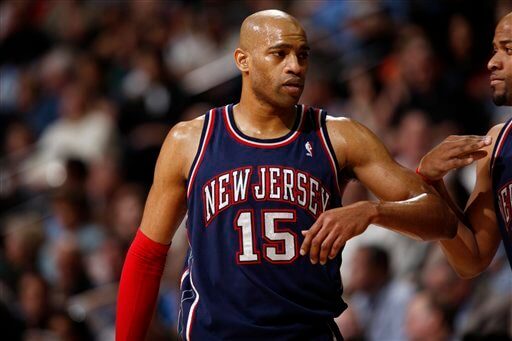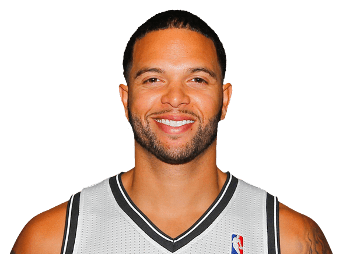The Nets haven’t gone on too many runs this year, but in their last game against the Raptors the Nets went on a 20-3 run that extended over 6 minutes. How did they do this? Is this something that they can use as a template in the future? Let’s take a look.
They Got To The Line
During this six minute stretch, the Nets were able to get to the line 5 times, hitting on 4 of them. If you read this blog on a consistent basis, you know I harp on this. The Nets are a very good foul shooting team, so getting to the line is guaranteed points. Why were they able to get to the line so much during this stretch? They were aggressive:

Here, Marco Bellini is putting some serious pressure on Terrence Williams. He must not have gotten the scouting report, to play Terrence, you should be giving him space giving up the shot.

Terrence pivots and rips the ball through. He then starts his attack. Look at the help defender. He isn’t selling out on his help because Terrence Williams is now know for getting into the lane and kicking the ball out (plus the Nets’ only shooter Chris Quinn is on the help side).

That little lane allows for Terrence Williams to get all the way to the rim. The help comes a little late, and Terrence Williams is able to get the foul call.
They Shot Well
The Nets didn’t miss any shots during this 20-3 run. Don’t laugh, I am serious. The Nets were 7-7 from the field during this six minute stretch. A lot of it had to do with getting into the lane:

CDR gets the rebound, and he is in attack mode. CDR is starting to get more aggressive (turning back to his old self), and that was really apparent during this run.

As he is bringing the ball up, Brook gives CDR a screen. Brook is really good at this. Usually as he runs the floor, if he doesn’t beat his man, he sets a screen. This usually gets the Nets a quick hitting basket when it is effective.

When he comes off the screen, he does something that Nets’ fan haven’t seen in a while. He attacks. Instead of passing it off or settling for a jumper on the wing, CDR takes an extra dribble and gets into the paint.

He then pulls up for a jumper, nailing it over the defender.
They Hit Some Threes
It is no secret that the Nets aren’t great from the three point line, but during this stretch, the Nets were able to knock down both threes that were attempted. The Nets were able to free up their shooter (Chris Quinn) and find him in spots where he can knock down shots:

Again we have CDR getting the rebound and bringing the ball up. The beauty of having two guys who can bring the ball up (CDR and Terrence Williams) while playing with Chris Quinn is that it allows Quinn to get down the floor and spot up without worrying about bringing the ball up (one of Quinn’s weaknesses). It makes him more effective.

Brook sets another one of his screens. Again, we see the old (and better) CDR. Recently, CDR has been settling, and I was half expecting CDR to pass out of this screen (which is something he has been doing way too much). Instead, he attacks the basket.

His attack dribble draws the help, and you have Chris Quinn spotting up in the corner.

Quinn makes the catch, and with no defender closing out, CDR knocks it down.
They Played Defense
During the Kiki era, the Nets haven’t been a good defensive team at all. During this 20-3 run, the Nets were able to play some good defense. They didn’t let the Raptors hit a shot from the field (their 3 points came at the foul line), as the Raptors went 0-8, including 0-1 from three. So what was different during this stretch? Well, there was good rotation. The biggest difference was one little adjustment that the Nets made during this game:

So the little adjustment that the Nets made was having Chris Quinn putting “token pressure” on the point guard.

Quinn’s job here isn’t to steal the ball (though if he can, why not?). It is to put some pressure on the basketball and speed up things. If you are able to speed up most point guards, they tend to get away from what they are trying to do.

Here, instead of trying to set up the offense, Marcus Banks got so sped up that he is just going to take the ball to the basket, without even attempting to run an offensive set.

However, he is met in the middle by Kris Humphries, this is good rotation and good help.

Marcus Banks is still determined to get to the paint, so he tries a lay-up. It gets blocked by Humphries. Here is another stop. This time, the Nets were able to stop the Raptors in the half-court, with some smart off the ball defense:

Again, Chris Quinn is putting on the “token pressure” trying to get the Raptors out-of-sync.

It doesn’t work this time, but it does take up some of the shot-clock. Look at it. With 18 seconds, the Nets were able to waste 6 seconds of time.

The play the Raptors are running is one to try and get Bellini an open three point shot. Terrence Williams recognizes what they are doing, and instead of trailing Bellini through the screen, Terrence Williams goes over the top of it.

And looks what happens because of it. The pass can’t get made to Bellini, and it kind of blows up the rest of the set.

The ball ends up back in Bellini’s hand (notice how far away from the basket he has it). Brook’s man is going to set a screen for Bellini, and Brook is going to provide and excellent hedge.

Brook’s hard hedge forces Bellini to make a jump pass falling away from the target. This means the ball ends up getting lobbed, taking too long to get to the player.

This allows Terrence Williams time to close out, and forces a miss.

Nets’ fans are all too familiar with opposing teams getting offensive rebounds on them, so we know that a stop doesn’t happen until the Nets secure the ball. Here, the Nets are all boxing out fundamentally, and the ball bounces right into their hands. I wanted to show you one more screenshot:

This was after a few possessions of Chris Quinn putting pressure on the basketball. Chris Bosh is now in the backcourt setting a screen for the point guard. Not a big deal right? Wrong. The Raptors are using their best player to set a screen in the backcourt. That means he isn’t on the offensive end getting open. So in essence, the Nets were able to take the Raptors best player out of the game, just by putting pressure on the point guard.
Final Takeaway
The Nets aren’t going to make every single shot they take, while holding their opponents to a shooting percentage of 0%. But there are things the Nets can take away from this run and use moving forward. The first thing is on the offensive end. In all of the plays I showed you, the ball was in the paint. Whether they were able to draw a foul, get a jumper, or kick it out for a three, the Nets were able to get into the lane and be productive. This is because when the ball gets into the lane, it forces defenders to make choices. When they make the wrong ones (or the right ones too slowly), open shots happen. Attacking the basket is a lot more effective than just passing it around the perimeter.
On the defensive end, “token pressure” can really help. This isn’t something that the Nets can do every single trip (I would use it against the back0up points, since starters are able to handle pressure better). Also, the Nets rotated correctly and boxed out. These are two things that the Nets haven’t been able to do in the past. If they are able to it on a consistent basis, they will be competitive in more games.
















